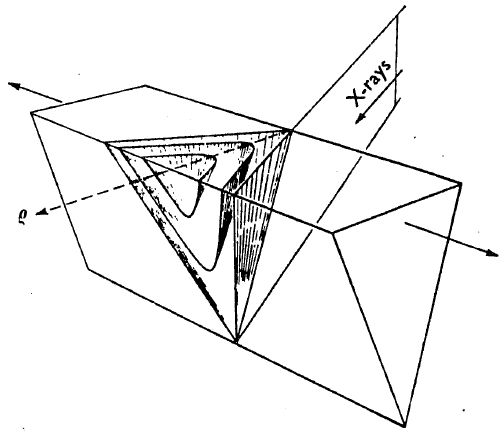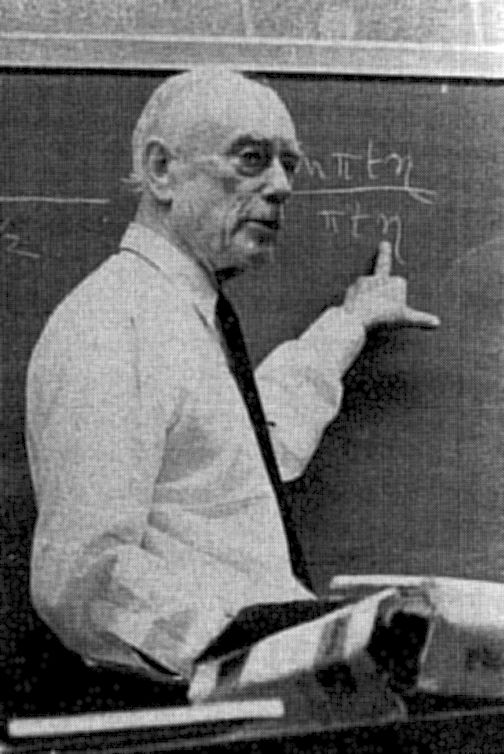


IUCr activities
Ewald Prize to Kato
The Third Ewald Prize will be presented to Prof. Norio Kato, Dept. of Physics, Meijo U., Nagoya, Japan at the opening ceremonies of the XVI Congress and General Assembly of IUCr in Beijing, China, Saturday, Aug. 21, 1993.
Early in his career, Prof. Kato made major contributions to the field of electron diffraction. After observing the Pendellösung fringe patterns (predicted by Ewald in 1916) in X-ray topographs of a quartz single crystal, in collaboration with Prof. A.R. Lang in 1959, Dr. Kato identified the failure of X-ray dynamical diffraction theory based on plane waves to account properly for the observed thickness dependence of the Pendellösung fringe spacings. He proposed an alternative theory based on spherical waves. After developing the diffraction theory of spherical waves for an ideally perfect single crystal, he extended the theory to allow its application to distorted crystals. He introduced the concept of the "eikonal", which had been widely used in the field of light scattering, into X-ray diffraction. He established the theoretical base for this technique which is fundamentally important in interpreting X-ray topographs correctly. The theory allows high resolution X-ray topographs to be interpreted reliably and quantitatively. Such topographs can be used to characterize perfect single crystals, and to analyze strain fields around defects.
 An illustration of intensity fields and section patterns from an early paper by Kato, "The Theoretical Study of Pendellösung Fringes", Acta Cryst. 14,627-636 (1961).
An illustration of intensity fields and section patterns from an early paper by Kato, "The Theoretical Study of Pendellösung Fringes", Acta Cryst. 14,627-636 (1961).
Among the large number of experimental studies related to his spherical wave theory for perfect and nearly perfect single crystals, the following are especially significant. First, the absolute measurement of the structure factors of a Si single crystal with an accuracy better than 0.05%, in collaboration with several authors. As a result of these studies it became possible to discuss the detailed electron density distribution of the bonding electrons in Si and in quartz. Second, he analyzed by X-ray topography the elastic strain distribution in a crystal under an applied stress. Kato recently developed a statistical dynamical theory of secondary extinction which forms an important bridge between primary and secondary extinction. This theory elucidates both the physical meaning and the limitations of the phenomenological theory of secondary extinction which is currently used in many least-squares refinements of X-ray diffraction data.
Norio Kato was born in 1923 in Shanghai and educated in Tokyo. He did his graduate work on electron diffraction at Nagoya U. and in 1954 obtained the Doctor of Science degree from that university. He started X-ray diffraction work at Kobayashi Inst. of Phys. Res. (Tokyo). After postdoctoral work on X-ray dynamical diffraction and topography at Harvard U. (USA) and the U. of Bristol (UK) he returned to Nagoya U. as Prof. of Applied Physics. In 1977 he moved to the Dept. of Crystalline Materials Science.
Kato was elected as a member of the Executive Committee of the IUCr (1968-72) and served as its President (1978-81) and Past President (1981-84). He was a member of the International Advisory Board of the International Organization of Crystal Growth (1967-77) and a co-editor of the J. of Crystal Growth (1967-77). These notes on Prof. Kato's career accomplishments were provided by the chairman of the Ewald Prize Selection Committee, T. Hahn.
 Paul Ewald lecturing at a Direct Methods Workshop in Buffalo, July 1972. Photo courtesy of the Medical Foundation of Buffalo.
Paul Ewald lecturing at a Direct Methods Workshop in Buffalo, July 1972. Photo courtesy of the Medical Foundation of Buffalo.
For the benefit of young crystallographers it may be worth offering a short history of P.P. Ewald for whom the prize is named. Paul Ewald, the last surviving founder of X-ray crystallography, died in 1985. His obituary, published in Acta Cryst. in 1986 (A45, 1-5),was composed by J.J. Dropkin and B. Post and included Ewald's own version of an obituary for himself that he prepared in 1958. Therein Ewald describes himself as a scientist who was attracted to a problem at an early stage of his development that occupied him throughout his life. At 15 or 16 he read a biography of Helmholtz and became interested in using the properties of light in order to find the ultimate atomic structure of matter. Ewald took as his thesis project a discussion of whether a periodic anisotropic spatial arrangement of resonators led to the laws of double refraction. Much of Ewald's later work consists of further applications of the methods used in his dissertation. The dynamical theory of X-ray diffraction was conceived and carried out by Ewald while a medical X-ray technician in the German army from 1915 to 1918 on the front near Dwinsk.
"By 1929 at least half a dozen books on X-ray crystal analysis had appeared and in most of them, in order to facilitate their use, tables of point groups, space groups, coordinates of equivalent positions, X-ray wavelengths, absorption coefficients, and the like were given. Some of the tables contained errors and few of them were alike in using the same conventions regarding setting or choice of origin." Consequently, Ewald and J.D. Bernal urged that an International Tables for the Determination of Crystal Structures should be prepared. In 1949 he became the driving force behind the establishment of an International Union of Crystallography. In 1946 Ewald was asked to organize an international journal of crystallography and Acta Crystallographica was born.
Ewald taught mathematical physics for 18 years in Germany, 10 years in the UK, and 9 years in the USA. He resigned from the Technische Hochschule at Stüttgart after a law was promulgated by which all Jewish professors were dismissed. "The Nazi student body expressed their qualified regret in a letter at parting from a rector whose views they could not share but whose fairness and personality they otherwise respected! Ewald left Germany for Britain in 1937 and settled in the USA in 1948. He was President of the American Crystallographic Assn. in 1952 and a member of the USA National Committee for Crystallography from 1950-1966. Ewald strove to be remembered by his juniors and students as a friend and not as a boss (even if he did not always achieve this), by his friends as reliable and honest, and by his fellow scientists as a faithful servant to science. RIP." - P.P. Ewald.
Dropkin and Post note that Ewald continued to work on his "thesis problem" until he was in his nineties. He was awarded the first Gregori Aminoff Medal of the Royal Swedish Academy of Sciences in 1979. In the past two years several of Ewald's landmark papers have been reprinted in monographs published by the ACA and the IUCr. In 1992, P.P. Ewald and His Dynamical Theory of X-ray Diffraction, the 2nd IUCr Monograph on Crystallography, was published by Oxford U. Press. This memorial volume, a survey of his life, scientific work, and role in the international crystallographic community, includes contributions by N. Kato, G. Hildebrand, H.A. Bethe, M.F. Perutz, D.C. Hodgkin, H. Kamminga, H.J. Juretschke, D.W.J. Cruickshank, D.H. Templeton, A. Authier, B. Capelle, R. Colella, J.M. Cowley, A.F. Moodie, R.K. Bullough, and F. Hynne. The volume, edited by D.W.J. Cruickshank, H.J. Juretschke, and N. Kato, includes five of Ewald's key papers. Four more of Ewald's fundamental papers on the Foundation of Crystal Optics, translated by L.M. Hollingsworth and edited by H.J. Juretschke, have been published as an ACA monograph that is available from Polycrystal Book Service. We are saddened to add this final word. On March 14, 1993, Ella Philippson Ewald died at the age of 101 in her home in Ithaca, NY, USA.


